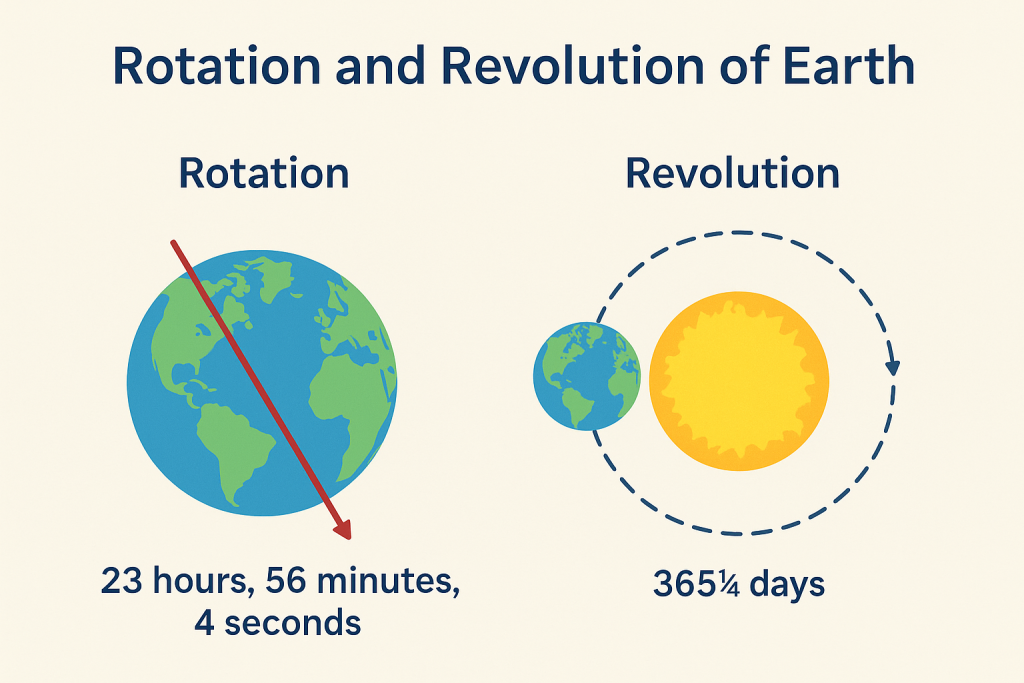
Effects Produced Due to the Rotation and Revolution of Earth
The Earth is constantly in motion, performing two main types of movements — rotation and revolution. Both of these motions have profound geographical, climatic, and environmental impacts on our planet.
1. Effects of the Earth’s Rotation
Definition:
Rotation refers to the spinning of the Earth on its own axis from west to east. The Earth completes one full rotation in approximately 23 hours, 56 minutes, and 4 seconds.
Major Effects:
a) Formation of Day and Night:
The most fundamental effect of rotation is the regular alternation of day and night. As the Earth spins, only one half of it faces the Sun and experiences daylight, while the other half remains in darkness, leading to night.
b) Apparent Movement of Celestial Bodies:
Due to the Earth’s rotation, the Sun, Moon, and stars appear to move across the sky from east to west. In reality, this apparent movement results from the Earth’s own motion from west to east.
c) Time and Longitude:
Rotation causes differences in local time across various longitudes. The Earth rotates 360° in 24 hours, meaning it covers 15° per hour. Therefore, every 15° of longitude corresponds to a difference of one hour in local time. This principle forms the basis of time zones.
d) Deflection of Winds and Ocean Currents (Coriolis Effect):
The rotation of the Earth influences the direction of global wind and ocean current systems. In the Northern Hemisphere, moving air and water are deflected to the right, while in the Southern Hemisphere, they are deflected to the left. This is known as the Coriolis effect, which plays a vital role in shaping weather systems and ocean circulation patterns.
e) Shape of the Earth (Oblate Spheroid):
Due to rotation, the Earth is not a perfect sphere; it bulges slightly at the equator and flattens at the poles. This oblate shape results from the centrifugal force generated by rotation.
2. Effects of the Earth’s Revolution
Definition:
Revolution refers to the Earth’s movement around the Sun in an elliptical orbit. It takes 365¼ days (one year) to complete one revolution. The Earth’s axis is tilted at an angle of 23½° to the plane of its orbit, known as the ecliptic.
Major Effects:
a) Change of Seasons:
The revolution of the Earth, combined with the axial tilt, causes the four seasons — spring, summer, autumn, and winter. When the Northern Hemisphere is tilted towards the Sun, it experiences summer, while the Southern Hemisphere experiences winter, and vice versa.
b) Variation in the Length of Day and Night:
As the Earth revolves around the Sun, the tilt of its axis causes the Sun’s rays to fall differently on various parts of the globe. This results in longer days and shorter nights in summer, and the reverse in winter.
c) Changing Altitude of the Midday Sun:
The Sun appears higher in the sky during summer and lower during winter. This variation in solar altitude affects temperature and climate patterns globally.
d) Migration of the Overhead Sun:
The apparent movement of the Sun between the Tropic of Cancer (23½° N) and the Tropic of Capricorn (23½° S) during the year is due to revolution. This movement affects climatic zones and the pattern of solar heating on Earth.
e) Determination of the Year and Calendar:
The revolution provides the basis for measuring one year. The additional ¼ day after every 365 days accumulates to form an extra day every four years — giving rise to the leap year.
Conclusion
The rotation and revolution of Earth are fundamental motions that govern the rhythms of natural phenomena on our planet. Rotation determines the alternation of day and night, influences time zones, and shapes global wind patterns, while revolution, coupled with axial tilt, gives rise to the changing seasons and varying lengths of days and nights. Together, these two motions sustain the dynamic balance that characterizes life on Earth.
Related Posts:
If a book originally cost $40 and is now on sale for 20% off, what is the new price of the book?
